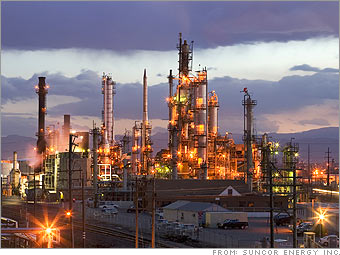Canada will shortly announce its plans to cut greenhouse gas emissions and other pollutants. All indications are that Canada’s targets will be “intensity” targets. In other words, Canada will want its pollution per unit of economic output. Greenhouse gas emissions can still rise under this scenario if economic output continues to grow.
Meanwhile, the European Union has set absolute emissions targets. In other words, the EU has committed that greenhouse gas emissions must fall even if economic output stays the same or increases:
Europe yesterday claimed leadership of the global battle against climate change as it agreed to slash carbon emissions and generate one fifth of its energy from renewables including solar and wind power.
At the end of a two-day summit, and after intensive cajoling from the German Chancellor, Angela Merkel, EU leaders signed up to a series of binding targets which will mean a dramatic change in the way Europe powers its economies.
However, they also gave comfort to countries that rely heavily on nuclear power, suggesting that they may be allowed to adopt less ambitious targets for generating wind, solar or hydro-electric power.
Yesterday's agreement commits the EU to a 20 per cent reduction in carbon emissions from 1990 levels by 2020 – though that will rise to 30 per cent if other nations follow suit. It also promises that, by the same date, one-fifth of EU energy will be derived from renewables – though the effort will not be shared equally among all 27 nations.
The environmental campaigning group Greenpeace hailed the deal as “the biggest such decision since the adoption of the Kyoto Protocol”. Nevertheless, yesterday's landmark agreement is just the beginning of a period of intensive wrangling over how the burden will be shared.
Europe yesterday claimed leadership of the global battle against climate change as it agreed to slash carbon emissions and generate one fifth of its energy from renewables including solar and wind power.
At the end of a two-day summit, and after intensive cajoling from the German Chancellor, Angela Merkel, EU leaders signed up to a series of binding targets which will mean a dramatic change in the way Europe powers its economies.
However, they also gave comfort to countries that rely heavily on nuclear power, suggesting that they may be allowed to adopt less ambitious targets for generating wind, solar or hydro-electric power.
Yesterday's agreement commits the EU to a 20 per cent reduction in carbon emissions from 1990 levels by 2020 – though that will rise to 30 per cent if other nations follow suit. It also promises that, by the same date, one-fifth of EU energy will be derived from renewables – though the effort will not be shared equally among all 27 nations.
The environmental campaigning group Greenpeace hailed the deal as “the biggest such decision since the adoption of the Kyoto Protocol”. Nevertheless, yesterday's landmark agreement is just the beginning of a period of intensive wrangling over how the burden will be shared.
The issue of ‘intensity’ vs ‘absolute’ targets has been an issue for environmental activists who believe they will not be very effective cutting greenhouse gases. But forgetting about the issue of environmental suitability for a moment, the issue is also important from an economic point-of-view. After listening to presentations at various House of Commons committees by environmental activists, think tanks, politicians, and company representatives, here’s what I understand to be the reason:
New international markets are emerging to ‘trade carbon’. Companies can buy and sell carbon credits on these markets. How does this work? Let’s say a regulator says all companies must emit no more than 100 tonnes of greenhouse gases in a year. Company A invests in ways to reduce GGEs and emits 90 tonnes. It earns 10 credits. Company B forgoes investments in GGEs and emits 110 tonnes. It must buy credits of 10 tonnes to comply with the regulations. In this scenario, Company A sells its credits and earns revenue. Company B has an added expense — the ten credits it must buy.
Almost all of these international markets in carbon trading are based on jurisdictions that have set absolute targets and not intensity targets. If Canada decides to set intensity targets, it could make it difficult or impossible for Canadian companies to participate in international carbon markets.
 Suncor Energy, one of the biggest operators in Canada’s oil sands (and, as a result, one of the country’s biggest generators of the greenhouse gas emissions that cause global warming) has been named as one of the
Suncor Energy, one of the biggest operators in Canada’s oil sands (and, as a result, one of the country’s biggest generators of the greenhouse gas emissions that cause global warming) has been named as one of the